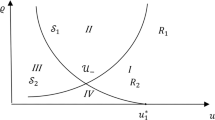Abstract
We consider a mixture composed of a gas and dust particles in a very rarefied setting. Whereas the dust particles are individually described, the surrounding gas is treated as a Knudsen gas, in such a way that interactions occur only between gas particles and dust by means of diffuse reflection phenomena. After introducing the model, we prove the existence and the uniqueness of the solution and provide a numerical strategy for the study of the equations. At the numerical level, we focus our attention on the phenomenon of energy transfer between the gas and the moving dust particles.





Similar content being viewed by others
References
Aoki, K., Golse, F.: On the speed of approach to equilibrium for a collisionless gas. Kinet. Relat. Models 1, 87–107 (2011)
Bernard, E., Salvarani, F.: On the convergence to equilibrium for degenerate transport problems. Arch. Ration. Mech. Anal. 208(3), 977–984 (2013)
Bernard, E., Salvarani, F.: On the exponential decay to equilibrium of the degenerate linear Boltzmann equation. J. Funct. Anal. 265(9), 1934–1954 (2013)
Bernard, E., Salvarani, F.: Optimal estimate of the spectral gap for the degenerate Goldstein-Taylor model. J. Stat. Phys. 153(2), 363–375 (2013)
Boatto, S., Golse, F.: Diffusion approximation of a Knudsen gas model: dependence of the diffusion constant upon the boundary condition. Asymptot. Anal. 31(2), 93–111 (2002)
Cavallaro, G., Marchioro, C.: On the motion of an elastic body in a free gas. Rep. Math. Phys. 69(2), 251–264 (2012)
Charles, F., Copol, C., Dellacherie, S., Mounsamy, J.-M.: Numerical simulation by a random particle method of deuterium-tritium reactions in a plasma. ESAIM Proc. 38, 220–240 (2012)
Darrozes, J., Guiraud, J.: Généralisation formelle du théorème H en présence de parois. Applications. C. R. Hebd. Séances Acad. Sci., Sér. A 262(24), 1368 (1966)
De Vuyst, F., Salvarani, F.: Gpu-accelerated numerical simulations of the Knudsen gas on time-dependent domains. Comput. Phys. Commun. 184(3), 532–536 (2013)
De Vuyst, F., Salvarani, F.: Numerical simulations of degenerate transport problems. Kinet. Relat. Models 7(3), 463–476 (2014)
Han-Kwan, D., Léautaud, M.: Geometric analysis of the linear Boltzmann equation I. Trend to equilibrium. Ann. PDE 1(1), 3 (2015)
Salvarani, F.: On the linear Boltzmann equation in evolutionary domains with an absorbing boundary. J. Phys. A 46(35), 355501 (2013)
Sgobba, T., Allahdadi, F.A., Rongier, I., Wilde, P.D.: Safety Design for Space Operations. Butterworth-Heinemann, Stoneham (2013)
Sone, Y.: Molecular Gas Dynamics. Theory, Techniques, and Applications. Modeling and Simulation in Science, Engineering and Technology Birkhäuser Boston, Boston (2007)
Tsuji, T., Aoki, K., Golse, F.: Relaxation of a free-molecular gas to equilibrium caused by interaction with vessel wall. J. Stat. Phys. 140(3), 518–543 (2010)
Acknowledgements
This work has been carried out in the framework of the projects Kimega (ANR-14-ACHN-0030-01), PHC Sakura “Dynamics of small particles in fluids: modeling and numerics” and of the Galileo program of the Università Italo-Francese. This research was moreover supported by the Italian Ministry of Education, University and Research (MIUR), Dipartimenti di Eccellenza Program—Dept. of Mathematics “F. Casorati”, University of Pavia.
Author information
Authors and Affiliations
Corresponding author
Additional information
Publisher’s Note
Springer Nature remains neutral with regard to jurisdictional claims in published maps and institutional affiliations.
Appendix: Numerical Treatment of the Diffuse Reflexion Mechanism
Appendix: Numerical Treatment of the Diffuse Reflexion Mechanism
We describe here the treatment of the boundary condition (2.7) on the moving boundary \(\varGamma ^{t}\), adapted from the treatment of a diffuse reflexion condition on a fixed boundary at temperature \(T_{p}\) (see [14]). For the sake of simplicity, we normalize the mass \(m\) and the Boltzmann constant \(k_{B}\). If a numerical particle hits the boundary \(\varGamma ^{t}\) at \(x\), then its velocity will be generated by sampling from the half Maxwellian \(h(v-c(t,x))\), where

where \(\ell \) is the dimension (\(\ell \in \{2,3\}\)). Because of its normalization, \(h\) is a probability density. If we note \(v= (v_{1}, v _{\perp } )\), with \(v_{1} = v\cdot n_{x} \), then \(h\) can be written as the product \(h(v)=h_{1}(v_{1}) \, h_{2} (v_{\perp })\), with

The repartition function \(\psi _{1}(s) = 1- \exp (-{s^{2}}/{2 T _{p}} ) \) of \(h_{1}\) is invertible, and
Assume now \(l=2\). As we cannot explicitly express the repartition function \(\psi _{2}\) of \(h_{2}\), we use the classical trick to simulate a Gaussian random variable, by working with polar variables—\((w_{1},w_{2}) \rightarrow (R,\theta )\), with \(w_{1}=R\cos (\theta )\) and \(w_{2}= R \sin (\theta )\)—in the joint density of \((w_{1},w_{2})\):
This allow to invert the repartition function of the variable \(R\). We then randomly compute \(V_{r} = (V_{r1}, V_{r\perp })\) following the law \(h\) by sampling three independent random variables \(U_{1}\), \(U_{2}\) and \(U_{3}\), following a uniform law on \([0,1]\), and set
Finally the velocity of the numerical particle after reflexion on boundary \(\varGamma ^{t}\) is set to
Rights and permissions
About this article
Cite this article
Charles, F., Salvarani, F. Mathematical and Numerical Study of a Dusty Knudsen Gas Mixture. Acta Appl Math 168, 17–31 (2020). https://doi.org/10.1007/s10440-019-00277-x
Received:
Accepted:
Published:
Issue Date:
DOI: https://doi.org/10.1007/s10440-019-00277-x




